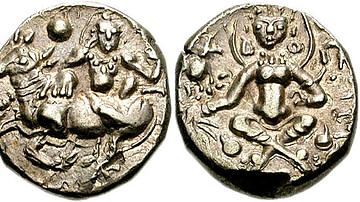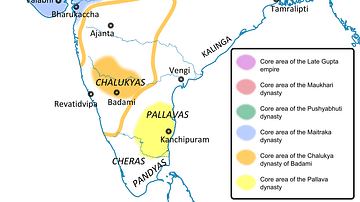
Emperor Harshavardhana, better known as Harsha, lived from 590 to 647 CE and was the last ruler of the Vardhana Empire, the last great empire in ancient India before the Islamic Invasion. He ruled from 606 CE to 647 CE. After Harshavardhana's death, however, the Vardhana or Pushyabhuti Dynasty came to an end and its empire dissolved.
India, the land beyond the Indus river, has seen many rulers who dreamt of conquering the vast country and rule from the Himalayas in the north to Deccan in south, from the mountains of Kandhar in the west to Assam in the east, yet very few have been able to subdue history according to their will. Harshavardhana was one such ruler. His empire may not be as large as the great Mauryan's, yet he deserves special mention. After the fall of great Gupta Empire in the middle of the 6th century CE, under whom India saw its own golden age, it was Harshavardhana who unified most of northern India and ruled for four decades from his capital Kanyakubja.
RISE TO POWER & MILITARY CAMPAIGNS
The Pushyabhuti Dynasty's origin is uncertain, but sources become clearer from c. 580 CE when Prabhakaravardhana ruled the kingdom of Thaneshwar, modern-day Haryana. Prabhakaravardana's queen Yasovati gave birth to two sons Rajyavardhana and Harshavardhana and a daughter named Rajyashri who was later married to king Grahvarman of Kanyakubja, modern-day Kannauj. This was a period of tension as India had to frequently deal with the invasion of the Huns of Central Asia. Constant fights were so costly that they weakened the empire to the core, and this eventually led to the downfall of the Gupta Empire. As the western frontiers of India and areas adjoining the Indus river were under the occupation of Huns, skirmishes between Huns and Thaneshwar were regular. While Harsha and his brother were busy dealing with the Huns in the west, Prabhakaravardana died in Thaneshwar. He was succeeded by his elder son, Rajyavardhana.
Meanwhile, in the east far greater events were happening which altered the course of history. Shashanka of the Gauda Kingdom, modern-day Bengal, marched and killed king Grahvarmana, Rajyashri's husband, and then kidnapped her. The kidnapping of his sister forced the elder Vardhana brother to march east and confront Shashanka. Shashanka then invited Rajyavardhana for a meeting and treacherously killed him. After his brother's death, at the age of 16, Harshavardhana became the undisputed ruler of Thaneshwar and declared war on Sasaka to avenge his brother and embarked upon a campaign of Digvijay, i.e. to conquer the world (which in this context means conquering whole India). Yet, his foremost enemy was now Shashanka who had to face an angry brother's wrath. Harsha issued a proclamation to all kings known to either declare allegiance to him or face him on the battlefield. As Shashanka's enemies responded to Harsha's call, he marched on to Kannuaj.
Although there is no evidence, a story in Harshacharitra claims that Rajyashri, when released from prison, took refuge in the forest of Vindhyas. Hearing this, Harsha hurriedly went into the forest to save her and found her just when she was about to commit suicide by throwing herself in a fire. Rescuing his sister, he rejoined his army at the bank of Ganges. After this, Harsha easily conquered Kanyakubja as Shashanka went back to Bengal, and thus began a long enmity. It was only after Shashanka's death that Harsha was able to control entire eastern India including Magadha, Bengal, and Kalinga.
Harsha's Digvijay, or the conquest of the world had now begun. After Kannauj, he turned his attention towards Gujarat. He defeated the local Valabhi kingdom and expanded his empire. Yet, this rapid expansion led to tensions between him and the Chalukya king Pulakeshin II (r. 609-642 CE). It was now that the most powerful kingdoms of northern and southern India came face-to-face on the battlefield on the banks of river Narmada. In the end, the southerners under the able leadership of Pulakeshin II prevailed leaving the ambitious northern ruler, Harsha, defeated. They say Harsha lost his cheer when he saw his elephants dying in the battle.
Harsha entered a peace treaty with the Chalukya king, which established Narmada river as the southern boundary of his empire and after that he never advanced south again. Yet, this did not halt his conquest of the north. He took the title of sakal uttara patha natha (lord of northern India). Hieun Tsang tells us that:
He waged incessant warfare, until in six years he had fought thr five Indians(referring to five largest kingdoms). Then, having enlarges his territory, he increased his army, bringing the elephant corps upto 60,000 and the cavalry upto 100,000, and reigned in peace for thirty years without raising a weapon (Majumdar, 252).
Yet many historians believe his claim may be exaggerated. Still, this gives a glimpse of his military prowess.
The Vardhana Empire consisted of two distinctive types of territories: areas directly under Harsha's rule such as Central Provinces, Gujarat, Bengal, Kalinga, Rajputana, and the states and kingdoms which had become feudatories under him including Jalandhar, Kashmir, Nepal, Sind, Kamarupa (modern-day Assam). Thus, many historians do not find the title justified as he was never able to bring the entire north under a single command. Yet, this does not mean his power was not felt beyond the limits of his direct rule. His writ ran across entire north India. Under his command, King of Jalandhar escorted the Chinese traveller Hiuen Tsang to the frontiers of India. Another time, king of Kashmir had to submit a tooth relic of Buddha to Harsha. The Chinese source suggests that the King of Kamarupa could not dare to detain a Chinese pilgrim in his capital against the wishes of Harsha.
ART & EDUCATION
Harsha was a patron of both art and education. He himself was an author and wrote three Sanskrit plays, Nagananda, Ratnavali, Priyadarshika. One-fourth of his revenue went for patronizing scholars. Hiuen Tsang gives a quite vivid description of the famous Nalanda University which was at its zenith during Harsha's reign. He described how the regularly laid-out towers, forests of pavilions, temples seemed to "soar above the mists in the sky" so that from their cells the monks "might witness the birth of the winds and clouds".
The pilgrim states:
An azure pool winds around the monasteries, adorned with the full-blown cups of the blue lotus; the dazzling red flowers of the lovely kanaka hang here and there, and outside groves of mango trees offer the inhabitants their dense and protective shade (Grousset,158,159).
In its heyday, Nalanda had around 10,000 students and 2,000 teachers. The admission process was very strict. Records say there was a rigorous oral examination conducted by gatekeepers, and many used to be rejected. The curriculum included Vedas, Buddhism, philosophy, logic, urban planning, medicine, law, astronomy, etc.
SOCIETY & RELIGION
Caste system was prevalent among Hindus. They were divided into four castes or varna: Brahmana, Vaishya, Kshariya and Shudra, which among them had their own subcastes. The untouchables, who came at the lowest in the hierarchy, led a miserable life. The status of women declined as compared to the liberal era of earlier times. Satipratha (widow immolation) was common, and widow remarriage was not allowed in higher castes.
Harsha was a worshiper of Shiva in the beginning but later became a Mahayana Buddhist. Yet, he was tolerant of other faiths. With a view to popularize and propagate the doctrines of Mahayana Buddhism, Harsha arranged at Kanyakubja a great assembly which was presided over by Hiuen Tsang. Hiuen Tsang took a lot of manuscripts to China and translated more than 600 of them from Sanskrit. Another great ceremony was held for 75 days at Prayag (Allahabad). The images of Buddha, Sun and Siva were worshiped, and gifts of valuable articles and clothing were distributed in charity. Every five years religious ceremonies were celebrated at the ancient city of Allahabad. Here, he held the ceremony of Dana, or giving, which lasted for three months. During this, most of the wealth accumulated in the last five years was exhausted. Once, he even gave his clothes and jewellery and begged his sister for an ordinary garment to wear.
DEATH & LEGACY
Harsha's empire marked the beginning of feudalism in India. Land was granted in villages, which made the local landlords powerful. This led to the weakening of the empire and gave rise to local feuds. Harsha had to be in constant movement to keep things in order.
Harsha died in 647 AD, and the empire with him. The death of Harshavardhana is not well documented. It is said that he was married to Durgavati and had two sons named Vagyavardhana and Kalyanvardhana. The story goes that they were killed by a minister in his court, even before the death of Harsha himself. Therefore, Harsha died without any heir. As a result, Arjuna, one of the chief ministers took up the thrones. Later in 648 CE, Arjuna was captured and held prisoner in an attack by the Tibetians.








